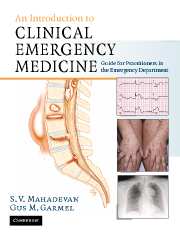Book contents
- Frontmatter
- Contents
- List of contributors
- Foreword
- Acknowledgments
- Dedication
- Section 1 Principles of Emergency Medicine
- Section 2 Primary Complaints
- 9 Abdominal pain
- 10 Abnormal behavior
- 11 Allergic reactions and anaphylactic syndromes
- 12 Altered mental status
- 13 Chest pain
- 14 Constipation
- 15 Crying and irritability
- 16 Diabetes-related emergencies
- 17 Diarrhea
- 18 Dizziness and vertigo
- 19 Ear pain, nosebleed and throat pain (ENT)
- 20 Extremity trauma
- 21 Eye pain, redness and visual loss
- 22 Fever in adults
- 23 Fever in children
- 24 Gastrointestinal bleeding
- 25 Headache
- 26 Hypertensive urgencies and emergencies
- 27 Joint pain
- 28 Low back pain
- 29 Pelvic pain
- 30 Rash
- 31 Scrotal pain
- 32 Seizures
- 33 Shortness of breath in adults
- 34 Shortness of breath in children
- 35 Syncope
- 36 Toxicologic emergencies
- 37 Urinary-related complaints
- 38 Vaginal bleeding
- 39 Vomiting
- 40 Weakness
- Section 3 Unique Issues in Emergency Medicine
- Section 4 Appendices
- Index
9 - Abdominal pain
Published online by Cambridge University Press: 27 October 2009
- Frontmatter
- Contents
- List of contributors
- Foreword
- Acknowledgments
- Dedication
- Section 1 Principles of Emergency Medicine
- Section 2 Primary Complaints
- 9 Abdominal pain
- 10 Abnormal behavior
- 11 Allergic reactions and anaphylactic syndromes
- 12 Altered mental status
- 13 Chest pain
- 14 Constipation
- 15 Crying and irritability
- 16 Diabetes-related emergencies
- 17 Diarrhea
- 18 Dizziness and vertigo
- 19 Ear pain, nosebleed and throat pain (ENT)
- 20 Extremity trauma
- 21 Eye pain, redness and visual loss
- 22 Fever in adults
- 23 Fever in children
- 24 Gastrointestinal bleeding
- 25 Headache
- 26 Hypertensive urgencies and emergencies
- 27 Joint pain
- 28 Low back pain
- 29 Pelvic pain
- 30 Rash
- 31 Scrotal pain
- 32 Seizures
- 33 Shortness of breath in adults
- 34 Shortness of breath in children
- 35 Syncope
- 36 Toxicologic emergencies
- 37 Urinary-related complaints
- 38 Vaginal bleeding
- 39 Vomiting
- 40 Weakness
- Section 3 Unique Issues in Emergency Medicine
- Section 4 Appendices
- Index
Summary
Scope of the problem
Evaluation of the patient with acute abdominal pain is one of the most challenging aspects of emergency medicine. Abdominal pain is the presenting complaint in as many as 10% of emergency department (ED) patients. Diagnostic possibilities range from immediately life-threatening conditions (e.g., ruptured abdominal aortic aneurysm (AAA)), to self-limiting (e.g., abdominal wall strain), and from common (e.g., gastroenteritis) to unusual (e.g., black widow spider bite). Though the etiology of pain is initially undetermined in as high as 30–40% of patients, recognition of surgical or life-threatening causes is more important than establishing a firm diagnosis.
Anatomic essentials
Abdominal pain is typically derived from one or more of three distinct pain pathways: visceral, parietal (somatic) and referred.
Visceral abdominal pain
Visceral abdominal pain is usually caused by distention of hollow organs or capsular stretching of solid organs. Less commonly, it is caused by ischemia or inflammation when tissue congestion sensitizes nerve endings of visceral pain fibers and lowers the threshold for stimulus. Often the earliest manifestation of a particular disease process, visceral pain may vary from a steady ache or vague discomfort to excruciating or colicky pain. If the involved organ is affected by peristalsis, the pain is often described as intermittent, crampy, or colicky in nature.
Since the visceral pain fibers are bilateral, unmyelinated, and enter the spinal cord at multiple levels, visceral abdominal pain is usually dull, poorly localized and experienced in the midline.
- Type
- Chapter
- Information
- An Introduction to Clinical Emergency MedicineGuide for Practitioners in the Emergency Department, pp. 145 - 160Publisher: Cambridge University PressPrint publication year: 2005

